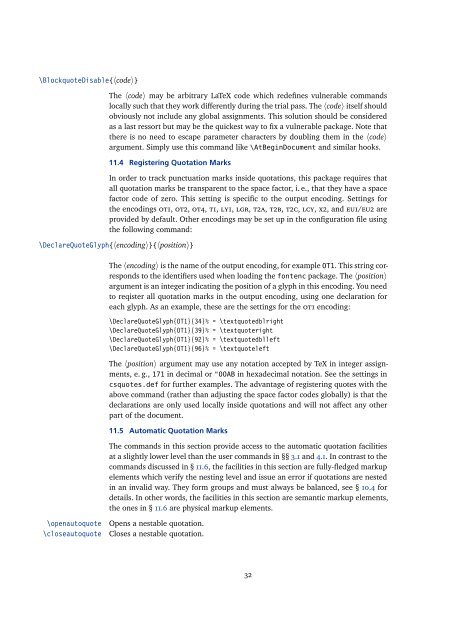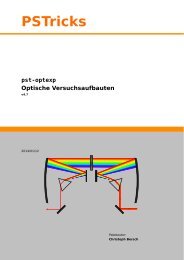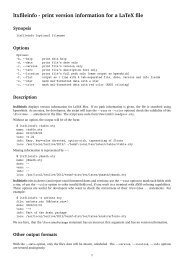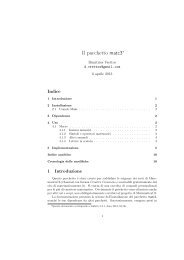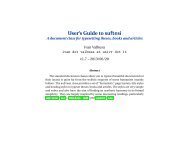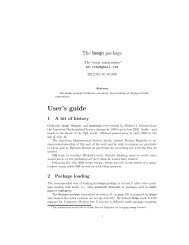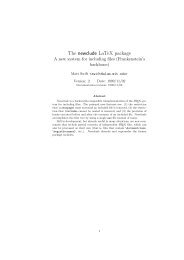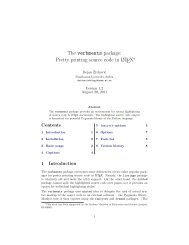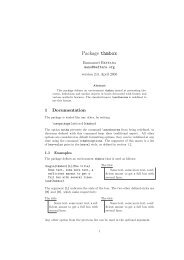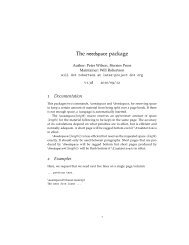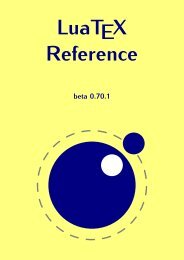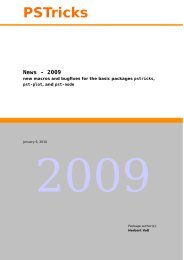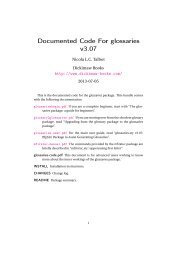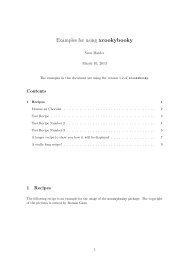The csquotes Package
The csquotes Package
The csquotes Package
You also want an ePaper? Increase the reach of your titles
YUMPU automatically turns print PDFs into web optimized ePapers that Google loves.
\BlockquoteDisable{〈code〉}<br />
<strong>The</strong> 〈code〉 may be arbitrary LaTeX code which redefines vulnerable commands<br />
locally such that they work dierently during the trial pass. <strong>The</strong> 〈code〉 itself should<br />
obviously not include any global assignments. This solution should be considered<br />
as a last ressort but may be the quickest way to fix a vulnerable package. Note that<br />
there is no need to escape parameter characters by doubling them in the 〈code〉<br />
argument. Simply use this command like \AtBeginDocument and similar hooks.<br />
11.4 Registering Quotation Marks<br />
In order to track punctuation marks inside quotations, this package requires that<br />
all quotation marks be transparent to the space factor, i. e., that they have a space<br />
factor code of zero. This setting is specific to the output encoding. Settings for<br />
the encodings 1, 2, 4, 1, 1, , 2, 2, 2, , 2, and 1/2 are<br />
provided by default. Other encodings may be set up in the configuration file using<br />
the following command:<br />
\DeclareQuoteGlyph{〈encoding〉}{〈position〉}<br />
<strong>The</strong> 〈encoding〉 is the name of the output encoding, for example OT1. This string corresponds<br />
to the identifiers used when loading the fontenc package. <strong>The</strong> 〈position〉<br />
argument is an integer indicating the position of a glyph in this encoding. You need<br />
to reqister all quotation marks in the output encoding, using one declaration for<br />
each glyph. As an example, these are the settings for the 1 encoding:<br />
\DeclareQuoteGlyph{OT1}{34}% = \textquotedblright<br />
\DeclareQuoteGlyph{OT1}{39}% = \textquoteright<br />
\DeclareQuoteGlyph{OT1}{92}% = \textquotedblleft<br />
\DeclareQuoteGlyph{OT1}{96}% = \textquoteleft<br />
<strong>The</strong> 〈position〉 argument may use any notation accepted by TeX in integer assignments,<br />
e. g., 171 in decimal or "00AB in hexadecimal notation. See the settings in<br />
<strong>csquotes</strong>.def for further examples. <strong>The</strong> advantage of registering quotes with the<br />
above command (rather than adjusting the space factor codes globally) is that the<br />
declarations are only used locally inside quotations and will not aect any other<br />
part of the document.<br />
11.5 Automatic Quotation Marks<br />
<strong>The</strong> commands in this section provide access to the automatic quotation facilities<br />
at a slightly lower level than the user commands in §§ 3.1 and 4.1. In contrast to the<br />
commands discussed in § 11.6, the facilities in this section are fully-fledged markup<br />
elements which verify the nesting level and issue an error if quotations are nested<br />
in an invalid way. <strong>The</strong>y form groups and must always be balanced, see § 10.4 for<br />
details. In other words, the facilities in this section are semantic markup elements,<br />
the ones in § 11.6 are physical markup elements.<br />
\openautoquote Opens a nestable quotation.<br />
\closeautoquote Closes a nestable quotation.<br />
32


